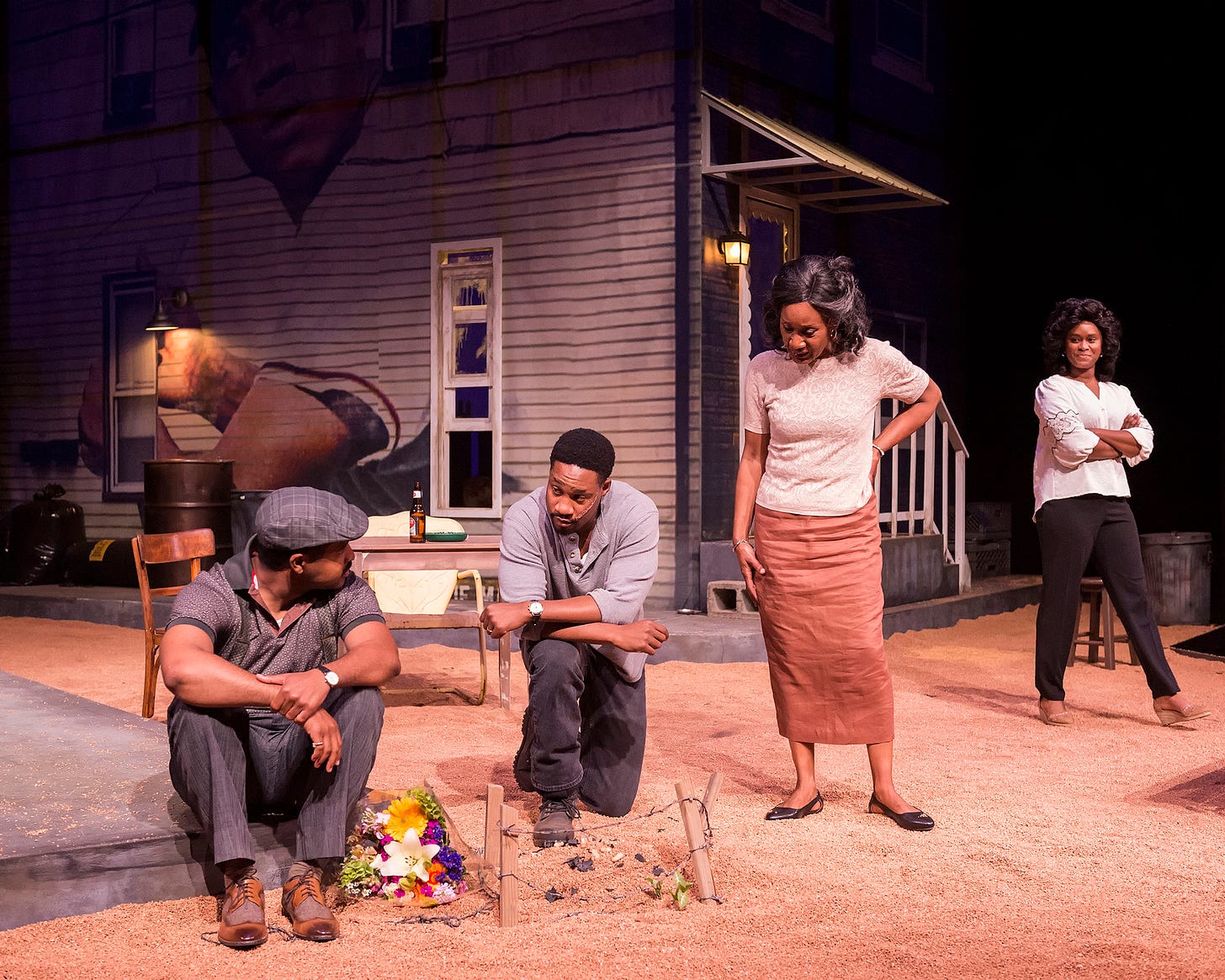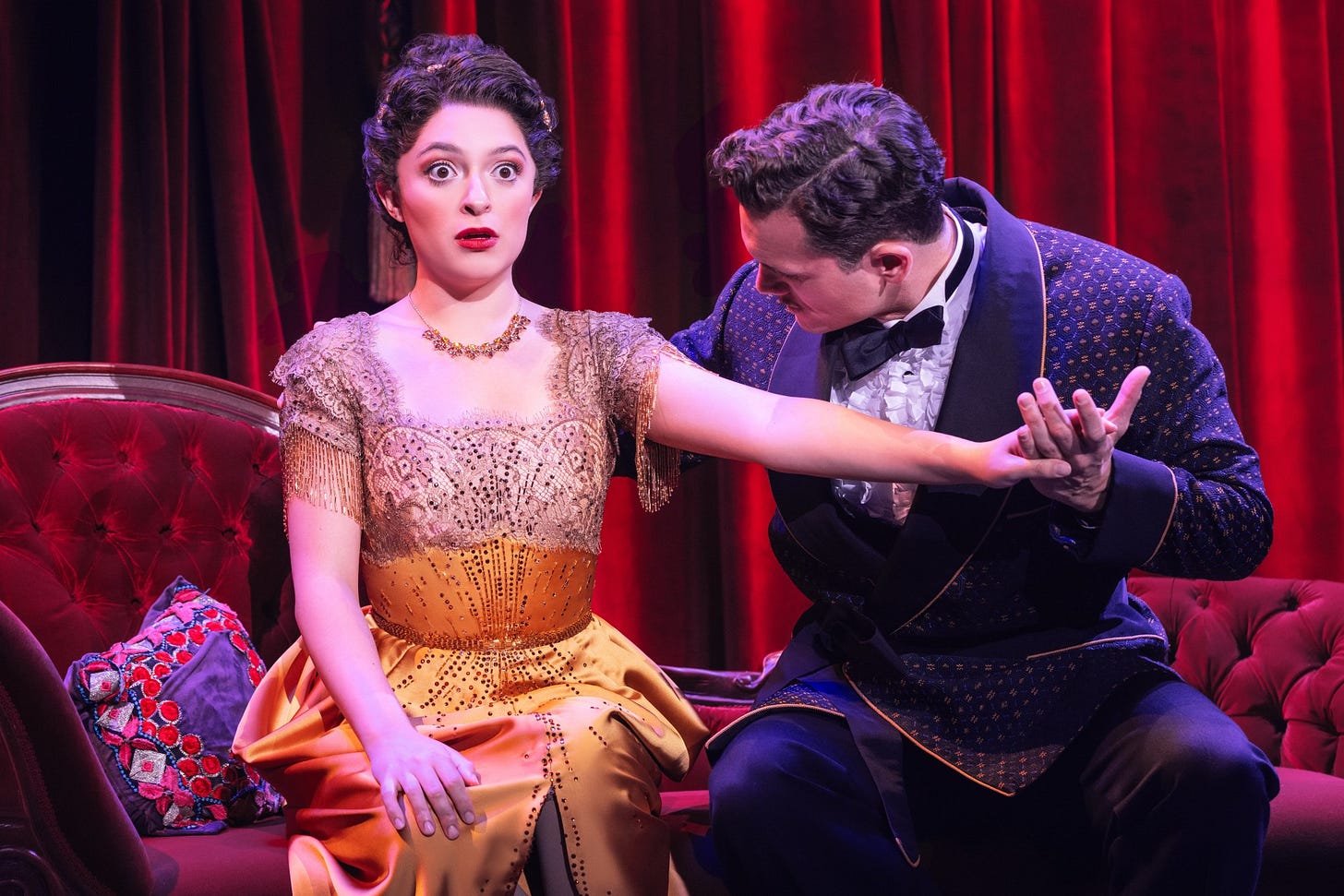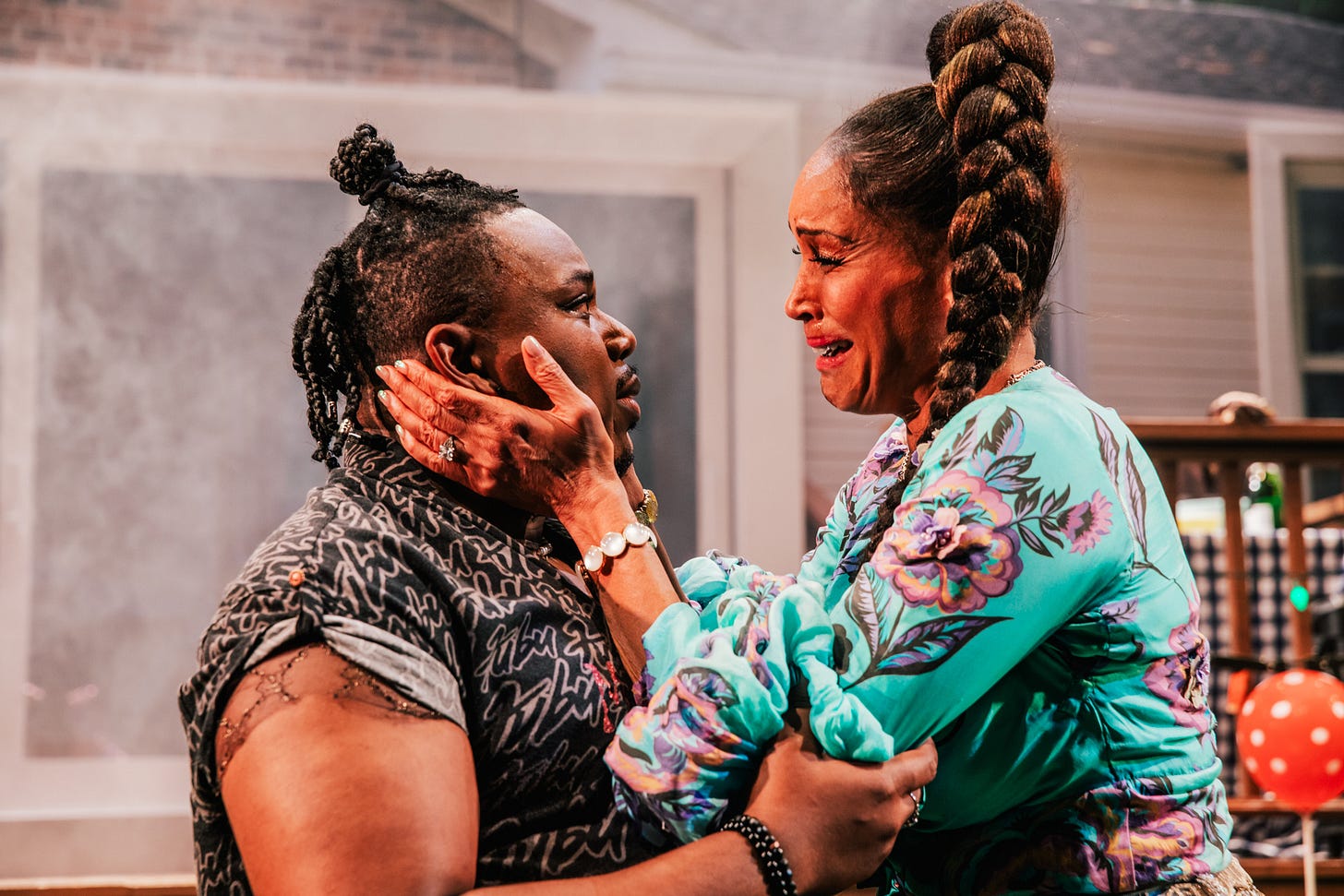'Ham,' meet "Hedley.' Plus plays looking forward, plays looking back
'Dinner With Friends,' 'Kairos,' 'High Maintenance,' 'Could I Have This Dance?,' 'Funny Girl,' Theatre 40 rep, 'Stalin's'. Online LADCC awards.
Two play openings in two consecutive days. Two back yards on two stages. Two Black families in the East grappling with extreme familial crises — including recent murders.
One of these productions, James Ijames’ “Fat Ham” at the Geffen Playhouse in Westwood, is a brisk, contemporary comedy that won the 2022 Pulitzer Prize.
The other, August Wilson’s “King Hedley II” at A Noise Within in Pasadena, is no comedy. It’s a bruising, ponderous play, set in 1985. It was nominated for the Pulitzer when it appeared more than 20 years ago — but it didn’t win, unlike two of Wilson’s earlier masterpieces, “Fences” and “The Piano Lesson” (fun factoid: Wilson won his first Pulitzer, for “Fences,” when he was more or less the same age as Ijames was when he won the award for “Fat Ham”).
In a fortuitous coincidence, Donald Margulies’ “Dinner with Friends” — the play that won the Pulitzer in 2000, edging out “King Hedley II” — is also currently receiving an LA revival, at the small Zephyr Theatre on Melrose Avenue.
Let’s discuss these three Pulitzer-related productions, beginning with the rousing “Fat Ham.”
The “Ham” refers primarily to the fact that the play is loosely based on Shakespeare’s “Hamlet”. But “Fat Ham” is set in the modern United States, probably in North Carolina. A young overweight man nicknamed Juicy (Marcel Spears), is disturbed that his recently widowed mother Tedra (Nikki Crawford) is marrying his late father’s brother Rev (Billy Eugene Jones). Then the ghost of his “Pap” (also Jones) suddenly appears, urging Juicy to avenge his murder, which “Pap” claims was plotted by — yes, the same Uncle Rev. The title also glances at the main dish of Rev’s menu at the wedding party — a recently deceased, barbecued pig.
Other characters in “Fat Ham” correspond, very tentatively, to Shakespeare’s Ophelia, Laertes, Polonius, and Horatio. But apparently it never occurred to Shakespeare to make three of his characters gay. It occurred to Ijames. Juicy, who has been studying “human resources” at the University of Phoenix, prefers his “soft” side to any desire to take up arms.
It also occurred to Ijames (pronounced “I’m’s”) that the original play’s monologues could become direct addresses to the live audience, acknowledging that we’re all in the same room. And that karaoke and charades — instead of a traveling players’ performance — could serve to reveal the usurper’s guilty conscience. And why not open the ending of the play to new opportunities, befitting today’s more open culture? Is a collection of corpses really necessary for the grand finale? I won’t explain exactly what happens — no spoilers here.
The director of this production is Sideeq Heard, but he uses many of the same actors who were in the play’s productions off- and on Broadway, which were directed by Saheem Ali. They’re all in top form. Anyone who was disappointed by a recent Geffen production (for example, “Black Cypress Bayou”) should not use it as a reason to miss “Fat Ham.”
Meanwhile, “King Hedley II”

Those who hear the title “King Hedley II” without knowing much about August Wilson — or Shakespeare — might wonder if it’s a little-known history play by the latter. But the title character here is a 36-year-old ex-con whose recidivism prospects are much greater than his job prospects — in Pittsburgh, 1985.
The plot of “Hedley” is tangled — and so much of it happens or happened offstage that it’s somewhat difficult to disentangle. Over three hours, we hear about previous and potential murders as well as small-time swindling. King’s wife and his mother (who was seen at a younger age in Wilson’s “Seven Guitars”) are probably the most sympathetic characters for most theatergoers. King himself tries to nurture a few tiny plants in what looks like sand in the yard — Wilson’s rather trite attempt to find glimmers of hope. An old sage collects newspapers on his next-door porch and rants, often incoherently.
As then-LA Times critic Michael Phillips wrote in his review of the pre-Broadway version of the play at the Mark Taper Forum, “its density…tends to flatten rather than deepen the characters.”
Patti Hartigan’s 2023 biography “August Wilson, a Life” gives the impression that Wilson had grown tired of creating his cycle of Pittsburgh plays — one of which was set during each decade of the 20th century — by the time that he wrote “King Hedley II.” Writing in her own voice as a Wilson expert and devotee, Hartigan refers to “Hedley” as “the weakest and most turgid play in Wilson’s cycle.” The playwright made changes to the script two days before the Broadway opening. It became “a box office disaster,” closing after just 72 performances, notes Hartigan.
However, A Noise Within — like more than a dozen other theater companies throughout the US — plans to produce all 10 plays in the cycle. “King Hedley” is the company’s fourth Wilson play, all of them so far directed by Gregg T. Daniel. The problems in the script don’t reflect poorly on Daniel or the actors (including Aaron Jennings’ King, Veralyn Jones’ Ruby, Kacie Rogers’ Tonya).
The company has yet to produce any of the better-known plays in the cycle: “Fences,” “The Piano Lesson,” “Ma Rainey’s Black Bottom,” “Joe Turner’s Come and Gone,” “Two Trains Running” or “Jitney.” So don’t let “Hedley” headwinds deter you from the company’s remaining adventures in Wilson’s “American Century” cycle. The best is yet to come.
Finally, a few words about “Dinner With Friends,” Margulies’ play that edged out “King Hedley II” and other nominees for the 2000 Pulitzer. In stark contrast to “Hedley,” it’s a compact but penetrating tale of two middle-aged married couples who are supposedly close friends in suburban Connecticut. But one of the marriages is secretly falling apart — the revelation of which shocks the other couple. All four characters must consider deeply how they’re spending their remaining years.
Peter Allas’ staging at the intimate Zephyr, an Adriano Aragon/Michael Donovan production with actors Jack Esformes, Marieh Delfino, Leith Burke and Amy Motta, probes into these “Friends” with the subtle delicacy it requires. If you want to know more about the play itself, here is my LA Times review of the West Coast premiere at South Coast Repertory in 1998.
‘What if’ plays
What if medical science develops a way for young thirtysomethings who win a lottery to stay alive, forever 34? That’s the question posed by Lisa Sanaye Dring’s “Kairos,” an East West Players production in Little Tokyo. This intriguing premise seems somewhat underdeveloped in Jesca Prudencio’s staging at the David Henry Hwang Theater. But maybe that was attributable to my particular seat on opening night, near the back of the venue’s mostly unraked first-floor auditorium. I had trouble seeing and hearing some of the exchanges, and I appreciated the script more when I read it after opening night. Sylvia Kwan and Gerard Joseph appeared, from a distance, to be quite capable as two meet-cute young adults with diverging opinions on whether to take the big leap into eternity — and other subjects. But the usual advantages of midsize theaters sometimes aren’t apparent in EWP’s home.
What if AI develops in theater to the extent that a robot is cast as Nora’s sexist husband Torvald in a revival of Ibsen’s classic “A Doll’s House”? This is less momentous than the question asked in the previous paragraph — and perhaps less likely considering that theater endures in the 21st century, despite our screen-obsessed culture, in part because it offers the chance to see real-live actors. But this situation creates some comedy in Chicago-based Peter Ritt’s “High Maintenance,” at the Road Theatre. Many of the laughs erupt from the performance of Christian Prentice as Roger, the “thesbot” in question, and his exchanges with Laura Miller (Ivy Khan), an actress who is tackling theater again after her TV career collapsed in a debacle that culminated with a fire on a studio lot in Burbank. It seems odd that the play is set in Ritt’s Chicago instead of, say, at a small theater near the Road in North Hollywood. Kris Frost is amusing as the AI promoter who is more or less Roger’s agent.
What if one of your parents had a debilitating disorder of the brain, usually inherited and often striking in midlife? Would you want to know your specific chance of contracting the same condition? That’s the dilemma in “Could I Have This Dance?” The 1991 premiere of Doug Haverty’s script was at the Colony Theatre’s original home (now the Elysian, a comedy theater) on Riverside Drive in Frogtown. Now Haverty has revived it with Group Repertory Theatre in North Hollywood, where he is the artistic director. Kathleen R. Delaney helms this lively rendition. While the sharp exchanges by most of the actors are well done, the almost-silent featured performance by Clara Rodriguez as the mother with Huntington’s disease enhances the play’s more moving moments. The script is set in LA in 1987, and design elements capably reflect that era.
‘What happened’ plays

Fanny Brice, a big deal in the first half of 20th-century American theater and radio, is most famous today because of Barbra Streisand’s star-making appearance as Fanny in the stage production, and then the movie, of the Jule Styne/Bob Merrill musical “Funny Girl”. In case you hadn’t noticed, the Ahmanson Theatre is currently hosting a tour of the first Broadway revival of “Funny Girl,” which is best known — besides Barbra — for such star-turn tunes as “People,” “Don’t Rain on My Parade” and “I’m the Greatest Star.” The musical’s book, even in its revised version by Harvey Fierstein, is easier to forget.
Katerina McCrimmon is justifiably winning raves as the newest Fanny. See Charles McNulty’s review of her — and the rest of the CTG version — in the LA Times. It’s also playing at the Segerstrom in Costa Mesa May 28-June 9.
I will add only that McCrimmon isn’t the first non-Barbra Fanny who wowed LA. After I saw Nicole Parker in the role in a 3-D Theatricals production in 2013, I remember thinking that surely Parker (previously an Elphaba on Broadway and part of the “Mad TV” troupe) would be the next Fanny on Broadway. No such luck. The current Broadway version, with Lea Michele’s Fanny now drawing raves, is the show’s first Broadway revival. Parker had probably aged out of the role by the time the Broadway revival was finally casting. Oh well — at least Parker garnered a Los Angeles Drama Critics Circle nomination and reviews such as this one from David Nichols in the LA Times.
Theatre 40 in Beverly Hills is currently offering two plays set in the American past, in repertory. The better of the two is “Into the Breeches.” George Brant’s comedy is primarily about the women who take over an LA theater company during World War II in order to assume the mostly-male roles in the planned production of Shakespeare’s Henriad plays – when most of the company’s men are off fighting the real-life war. Louis Fantasia’s staging gets a lot of laughs from its community-theater satire and drag-king costumes (created by Michael Mullen). But the play also makes more serious points about the stereotyped roles of women, Blacks and gays in the ‘40s, and the loneliness of those whose mates’ fates are unknown. International City Theatre in Long Beach introduced the play to LA County last year, referring to Long Beach as the site instead of LA. Here is what I wrote then. But among the advantages of Theatre 40’s production are some weekday performances and a longer run.
Too many years, 1884-1943, are covered in Theatre 40’s other current (pun intended) production, John Strysik’s “Power & Light,” about the dispute between the advocates of Thomas Edison’s DC current and those who supported Westinghouse’s/Tesla’s AC current. The recent movie “The Current Wars,” about the same subject, met some critical resistance for being discursive instead of dramatic, and that’s generally true here too. I’d rather read about this subject in Wikipedia than watch a play about it.
More 20th-century history is considered in the current Odyssey Theatre production of British playwright David Pownall’s “Stalin’s Master Class,” revived by director Ron Sossi 37 years after the Odyssey first produced it. It was then titled merely “Master Class” — but a Terrence McNally play with the same two-word title became better-known (at least in America), so “Stalin’s” was added.
In Pownall’s play, the Soviet dictator Joseph Stalin and a henchman summon the famous composers Sergei Prokofiev and Dmitri Shostakovich to a late-night meeting designed to force them to create less serious, more popular music. After a blistering temper tantrum ends the first act, the second is a bit anti-climactic, a point that the LA Times critic Dan Sullivan made in his 1987 review of the previous Odyssey production.
The encounter itself is fictitious, although Stalin’s government did indeed criticize “formalist” music in the late ‘40s. Perhaps Pownall’s play is again more pertinent in the Trump era. I didn’t know that America’s would-be dictator cares much about music, but Axios recently reported that he personally controls the Spotify playlist at Mar-a-Lago parties. His list of faves includes such songs as “Jesus Christ Superstar” and the Pavarotti/James Brown duet of “It’s a Man’s Man’s Man’s World.” Nothing by Prokofiev or Shostakovich made his list. Watch out, Philip Glass.
Did LADCC present the shortest awards ceremony ever?
Because I prominently featured A Noise Within’s 15 Los Angeles Drama Critics Circle nominations — almost twice as many as those received by any other company — in my February post, I should probably report that its basket of nominations yielded only one award for the east Pasadena company.
The little Theatre of NOTE in Hollywood received the one LADCC production award, for “Kill Shelter,” and NOTE and the big Pasadena Playhouse tied for the most awards given to single companies — four each.
The awards presentation was online-only. You can watch the half-hour video at the LADCC website, but the actual awards announcements didn’t last even that long. The brevity was due to the absence of components that many people expect from awards shows — a host cracking jokes, introductions of presenters, winners’ hugs in the aisles, unusual fashion displays, acceptance speeches and big (or small) scenes from the nominated shows (plus commercials, although LADCC sponsors did receive onscreen credits). Of course the awards extravaganzas that include all of those elements often provoke later comments that the show was too long.
So there, Oscars/Emmys/Tonys.
/



